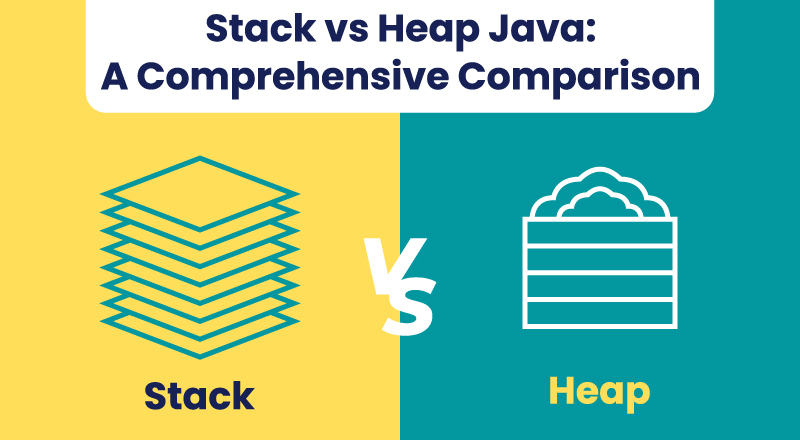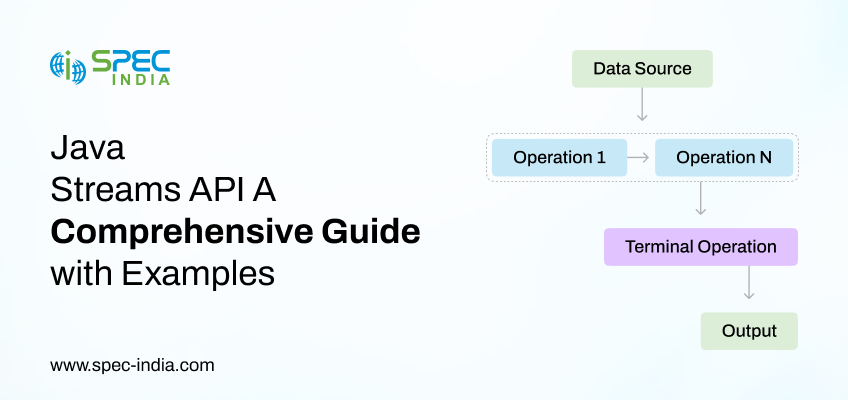Stack vs Heap Java: A Comprehensive Comparison
Posted
September 26, 2023

In Java, Stack and Heap are the fundamental aspects of Java memory management. This blog will compare the concepts of the stack and the heap in Java in terms of their differences, use cases, and best practices for efficient memory management.
Memory management is a crucial aspect of any programming language and Java is no exception. In Java, memory allocation and management are done using two primary areas: the Stack and the Heap. Understanding the differences between these two memory regions is essential for writing efficient and reliable Java programs.
What is Stack Memory in Java?
The stack memory, also known as the “call stack” or simply “the stack,” is a region of memory that is used for the execution of thread-specific method calls and local variables. It plays a crucial role in managing the flow of method invocations and their associated data.
It is essential for managing the execution context of methods, storing local variables, and facilitating method calls and returns. It operates efficiently and automatically manages memory, making it suitable for handling the control flow of a Java program.
However, it has a limited size, and developers need to be mindful of potential stack overflow errors when designing recursive or deeply nested code.
What is Heap Memory in Java?
The heap memory in Java is a region of memory used for allocating and managing objects and data structures with dynamic lifetimes. It is automatically managed by the Java Virtual Machine (JVM), including garbage collection to free up memory from objects no longer in use.
Heap memory is a critical part of Java’s memory management model and is essential for creating and managing objects in Java programs.
It’s responsible for accommodating dynamically allocated objects and data structures. Automatic garbage collection ensures efficient memory usage and helps prevent memory-related issues.
Stack vs Heap Java: The Core Differences
| Parameters |
Stack Memory |
Heap Memory |
| Storage |
The stack is a region of memory used for storing method call frames and local variables. Each method call in a Java program gets its stack frame, which contains information such as local variables, method parameters, and the return address. |
The heap is a region of memory used for dynamic memory allocation. It is where objects and data structures, whose lifetimes may extend beyond the scope of a single method, are stored. |
| Operation Method |
It operates on a Last-In-First-Out (LIFO) basis, meaning that the most recently called method is the first one to return. |
The memory allocation on the heap is more flexible and doesn’t have strict LIFO ordering. |
| Access Speed |
Accessing data on the stack is exceptionally fast. This is because it involves simple pointer manipulation, making it ideal for storing and retrieving small pieces of data quickly. |
Accessing data on the heap is relatively slower compared to the stack. It involves traversing references and can result in memory fragmentation over time as objects are created and destroyed. |
| Size |
The stack has a finite size determined either by the system or the Java Virtual Machine (JVM) configuration. When the stack space is exhausted, a StackOverflowError is thrown. This limitation ensures that the stack remains a resource-efficient memory region. |
Unlike the stack, the size of the heap is determined by the available system memory. While this provides ample space for data, it also means that excessive allocation can lead to an OutOfMemoryError if not managed carefully. |
| Clean Up |
Memory on the stack is automatically managed by the JVM. When a method call returns, its stack frame is immediately deallocated, and the memory is freed. This automatic management eliminates the need for manual memory cleanup. |
Memory on the heap is allocated and deallocated manually, either by the programmer or through Java’s automatic memory management system known as garbage collection. This flexibility enables the creation of objects with variable lifetimes. |
| Scope |
Variables declared on the stack are only accessible within the scope of the method they are declared in. They are not visible outside that method. |
It has a global scope. Objects on the heap are accessible from anywhere in the program, making them suitable for long-lived objects shared among multiple methods. |
Good Read: Go vs Java: Which Programming Language to Choose?
Stack vs Heap Java: When to Choose What?
The decision of whether to use the stack or the heap in your Java program depends on the specific requirements of your application:
| Parameters |
Stack |
Heap |
| Life Span |
The stack is the ideal choice for storing local variables with short lifetimes. These are typically primitive types and small objects that are required within a specific method. |
When you need to allocate memory dynamically and have objects with longer lifetimes or uncertain lifetimes, the heap is the go-to option. It allows for the creation of objects with variable and extended lifespans. |
| Efficiency |
The stack is ideal for managing method call frames in a call stack. It is efficient and ensures a quick method of invocation and return. |
The heap is ideal for complex data structures like arrays, lists, and objects with references to other objects. If multiple methods or threads need access to the same data, storing it on the heap ensures that the data is accessible globally. |
| Memory Requirement |
If you have a good understanding of the memory requirements of your application and can keep the stack size within limits, it can be a reliable choice. |
If you have large objects that would exceed the stack’s size limitations then they should be allocated on the heap. This prevents stack overflow errors and ensures that memory is available for objects of varying sizes. |
| Speed and Scope |
If you have methods that need data within these methods locally then storing it on the stack ensures that the data is accessible quickly. |
If you have multiple methods or threads that need access to the same data, storing it on the heap ensures that the data is accessible globally. This is particularly useful for data that needs to be shared across different parts of your program. |
Interesting Read: .NET vs Java: What’s Your Pick?
Best Practices for Memory Management
To write efficient Java code and make informed decisions about memory management, consider the following best practices:
Keep Stack Usage Minimal
Minimize the use of large local variables on the stack to avoid stack overflow errors. This involves carefully considering the size and scope of variables declared within methods.
Manage Heap Memory Carefully
Be mindful of memory allocation and deallocation on the heap. Leaking memory by not releasing objects no longer in use can lead to increased memory consumption and potential OutOfMemoryError issues.
Use Appropriate Data Structures
Choose the right data structures for your application’s needs. Small, short-lived objects can be allocated on the stack, while larger, long-lived objects and complex data structures should be placed on the heap.
Also Read: Java Developer: Roles & Responsibilities, Skills, Salary, And More
Profile and Optimize
Utilize profiling tools to identify memory bottlenecks in your code. Profiling helps pinpoint areas where memory usage can be optimized, leading to improved performance and resource utilization.
Thread Safety
When sharing data across multiple threads, ensure proper synchronization to avoid race conditions and maintain memory consistency. Java provides synchronization mechanisms like synchronized blocks and java. util.concurrent package to help with this.
Utilize Garbage Collection
Take advantage of Java’s garbage collection mechanisms to automatically release memory on the heap. Familiarize yourself with different garbage collection algorithms and tune them according to your application’s requirements.
Monitor Memory Usage
Implement monitoring and logging mechanisms to track memory usage in your Java applications. This can help you identify memory leaks and performance bottlenecks in real-time.
Consider Memory Pools
In some cases, it might be beneficial to use memory pools or object pools to manage memory more efficiently, especially for frequently created and destroyed objects.
Java Heap vs Stack: The Conclusion
In Java Web Development, the stack and heap represent two distinct memory regions with contrasting characteristics. Understanding when and how to use each is essential for writing efficient and reliable Java applications. By following best practices and being mindful of memory management, you can optimize your Java code for both performance and stability.
The right choice depends on your application’s specific requirements, whether it’s the stack for managing method call frames or the heap for dynamic memory allocation.
A well-informed approach to memory management will not only lead to more efficient code but also help you avoid common pitfalls associated with memory-related issues. Mastering the stack and heap is a critical step toward becoming a Experienced Java developer and building robust software solutions.
SPEC INDIA is your trusted partner for AI-driven software solutions, with proven expertise in digital transformation and innovative technology services. We deliver secure, reliable, and high-quality IT solutions to clients worldwide. As an ISO/IEC 27001:2022 certified company, we follow the highest standards for data security and quality. Our team applies proven project management methods, flexible engagement models, and modern infrastructure to deliver outstanding results. With skilled professionals and years of experience, we turn ideas into impactful solutions that drive business growth.






